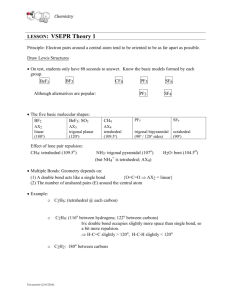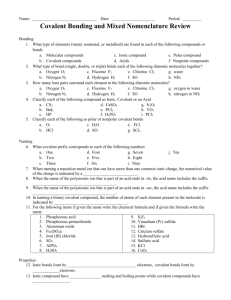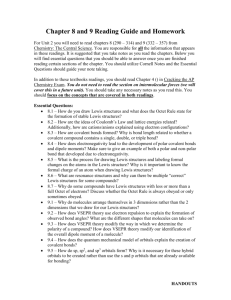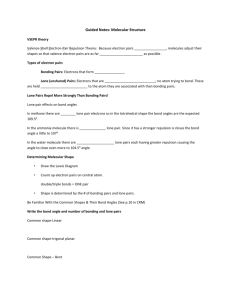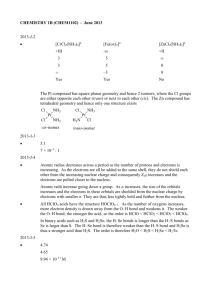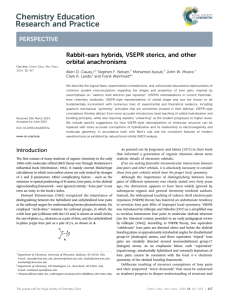Chapter 6 and 7 Homework
advertisement
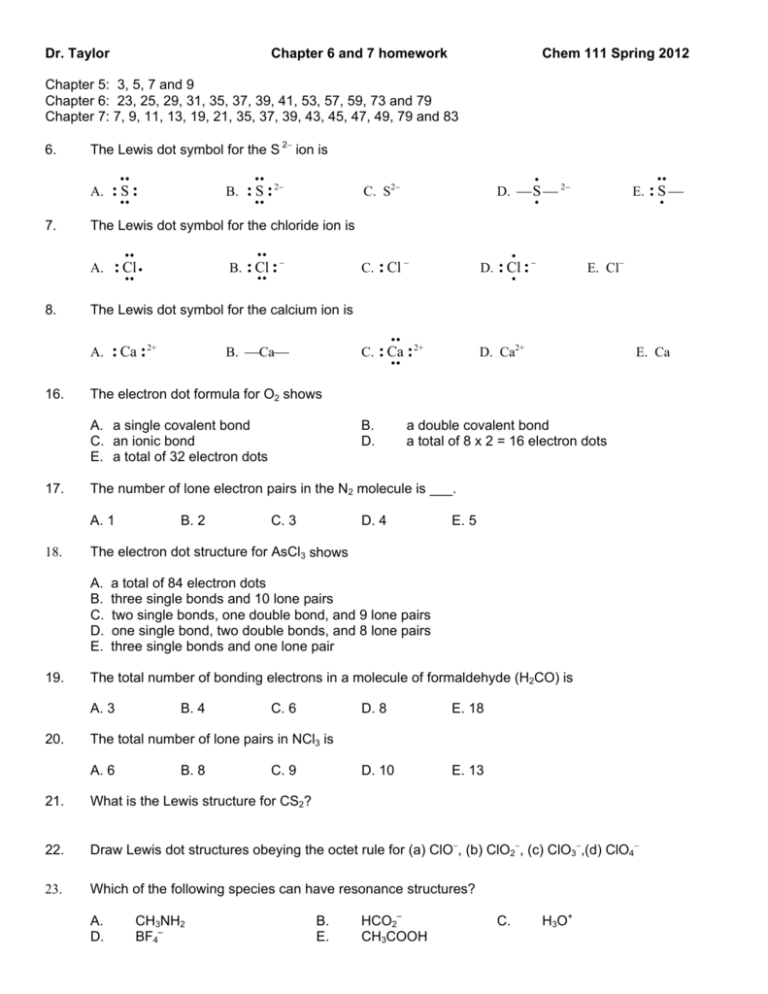
Dr. Taylor Chapter 6 and 7 homework Chem 111 Spring 2012 Chapter 5: 3, 5, 7 and 9 Chapter 6: 23, 25, 29, 31, 35, 37, 39, 41, 53, 57, 59, 73 and 79 Chapter 7: 7, 9, 11, 13, 19, 21, 35, 37, 39, 43, 45, 47, 49, 79 and 83 6. The Lewis dot symbol for the S 2 ion is A. 7. :S: B. B. : Cl : : Cl C. : Ca : 2+ D. Ca2+ E. Ca B. D. a double covalent bond a total of 8 x 2 = 16 electron dots The number of lone electron pairs in the N2 molecule is ___. B. 2 C. 3 D. 4 E. 5 The electron dot structure for AsCl3 shows a total of 84 electron dots three single bonds and 10 lone pairs two single bonds, one double bond, and 9 lone pairs one single bond, two double bonds, and 8 lone pairs three single bonds and one lone pair The total number of bonding electrons in a molecule of formaldehyde (H2CO) is A. 3 20. E. Cl The electron dot formula for O2 shows A. B. C. D. E. 19. D. : Cl : B. Ca : Ca : 2+ A. 1 18. C. : Cl A. a single covalent bond C. an ionic bond E. a total of 32 electron dots 17. E. : S The Lewis dot symbol for the calcium ion is A. 16. D. S 2 C. S2 The Lewis dot symbol for the chloride ion is A. 8. : S : 2 B. 4 C. 6 D. 8 E. 18 D. 10 E. 13 The total number of lone pairs in NCl3 is A. 6 B. 8 C. 9 21. What is the Lewis structure for CS2? 22. Draw Lewis dot structures obeying the octet rule for (a) ClO, (b) ClO2, (c) ClO3,(d) ClO4 23. Which of the following species can have resonance structures? A. D. CH3NH2 BF4– B. E. HCO2– CH3COOH C. H3O+ 24. Resonance forms can be written for A. NH3 B. H2S C. H2O D. OF2 25. How many resonance forms can be written for the NCS– ion? 26. For the Lewis structure below, what are the formal charges on N, C, and S? 27. For the Lewis structure below, what are the formal charges on C, S, and N? E. SO2 28. For the Lewis structure below, what are the formal charges on C, N, and O? 29. For the Lewis structure below, considering the atoms from left to right, the formal charges on N, N, and O, respectively, are 30. How many lone pairs are around Xe in XeO2? 31. Which of the following would have a Lewis structure most like that of ICl2+? A) XeF2 B) CO2 C) XeO2 D) I3– VSEPR Theory and Molecular Shape and Hybridization 1. What is the O–Cl–O bond angle in ClO4–? 2. What is the O–C–O bond angle in CO32– ? 3. What is the F–S–F bond angle in SF2? 4. Predict the shape FCl2+ 5. Predict the shape of AsF5 6. Predict the shape of AsF3 7. Predict the shape of SbH3 8. Predict the shape of SeO2 9. Predict the shape of IO4- E) O3 10. Predict the shape of ICl4- 11. Predict the shape of TeF6 12. Predict the shape of SiO44- 13. Predict the shape of ICl2- 14. Which of the following molecules would be expected to be polar? A. HBr B. POCl3 C. CH2O D. SnCl4 E. SbCl5 15. What is the shape of a molecule that has a VSEPR formula of AX3E? 16. What is the shape of a molecule with no multiple bonds and a central atom with five bonding pairs of electrons? 17. What is the shape of a molecule with no multiple bonds and a central atom with 2 bonding pairs and 1 lone pair of electrons? 18. What is the shape of a molecule that has a VSEPR formula of AX4E? 19. What is the shape of a molecule that has a VSEPR formula of AX5E? 20. The Lewis structure of the nitrite ion (NO2-) shows around the central nitrogen atom A. B. C. D. E. 2 single-bonded oxygens and 2 lone pairs of electrons. 2 double-bonded oxygens. 2 single-bonded oxygens and 1 double-bonded oxygen. 1 single-bonded oxygen, 1 double-bonded oxygen, and 1 lone pair of electrons. 3 single-bonded oxygens and 1 lone pair of electrons. 21. How many electron pairs (both bonding and lone pairs) are on the sulfur atom in SF4? 22. In the Lewis structure of SeF3+, the central atom has A. B. C. D. E. 23. 1 lone pair and 6 bonding pairs of electrons. 2 lone pairs of electrons. 1 lone pair of electrons. 2 lone pairs and 3 bonding pairs of electrons. 3 lone pairs of electrons. Which of the following molecules is polar? A. COS B. S2 C. CO2 D. CS2 E. O2 24. Which of the following molecules is polar? A. XeF4 B. CH4 C. SF6 D. PCl5 25. What type of hybrid orbitals best describe the bond between the two oxygen atoms in peroxyacetylnitrate (you will have to fill in the lone pairs)? 26. What type of hybrid orbitals best describe the bond between the two oxygen atoms in peroxymonosulfate (fill in lone pairs)? E. IF5 H–O–O–SO3– 27. What type of orbitals best describe the bond between carbon and oxygen atom 1 in peroxyacetic acid? One of the dominant resonance forms of diazomethane is 28. Describe the hybrid orbitals used to form the C–N bond and the N–N bond 29. What are the values of the H–C–N and C–N–N bond angles? 30. What set of hybrid orbitals are used by Xe in XeF4? 31. What set of hybrid orbitals are used by As in AsF5? 32. What set of hybrid orbitals are used by S in SF4? 33. What set of hybrid orbitals are used by Si in SiH4? 34. What set of hybrid orbitals are used by C in COCl2? 35. What set of hybrid orbitals is used by N in NO2–? 36. How many sigma and how many pi bonds are present in H3C–CH=CH–CH2–OH? (Hint-draw showing all bonds and lone pairs 37. How many sigma and how many pi bonds are present in CH2=C=CH2? 38. How many sigma and how many pi bonds are present in H3C–SCN? The structure of the amino acid histidine is shown below is for questions 39-42. 39. What hybrid orbitals are used on ring nitogen 1 and 2? 40. Describe the hybrid orbitals used to form the bond between ring nitrogen 1 and ring carbon 3. 41. What hybrid orbitals are used on the amino nitrogen 5? 42. What hybrid orbitals are used on carbon 4? Answers: Chemical Bonding and Lewis Structures 1. A 2. B 5. C 6. B 9. E 10. C 13. B 14. B 17. B 18. B 21. 3. B 7. B 11. E 15. A 19. D SCS 22. (a) (b) (c) .. .. : O : Cl : .. .. .. :O: .. .. : O : Cl : .. .. .. : O: .. .. : O : Cl : .. .. : O: .. 23. B 24. E 25. 3 26. –1, 0, 0 (N,C,S) 4. C 8. D 12. D 16. B 20. D (d) .. :O: .. .. .. : O : Cl : O : .. .. .. :O: .. 29. –1, +1, 0 (N,N,O) 27. –2, +2, –1 (C,S,N) 28. –2, +1, 0 (C,N,O) 30. 2 31. C VSEPR Theory and Molecular Shape and Hybridization 1. equal to 109° 2. equal to 120° 3. <109° 5. trigonal bipyramidal 6. trigonal pyramidal 7. trigonal pyramidal 9. tetrahedral 10. square planar 11. octahedral 13. linear 14. a, b and c 15. trigonal pyramidal 16. trigonal bipyramidal 17. angular 18. seesaw 20. D 21. 5 22. C 24. E 25. sp3–sp3 26. sp3–sp3 2 2 28. sp -sp; sp-sp 29. 120° and 180° 30. sp3d2 3 3 32. sp d 33. sp 34. sp2 36. 12 sigma and 1 pi 37. 6 sigma and 2 pi 38. 6 sigma and 2 pi 3 2 3 2 39. N1 is sp ; N2 is sp 40. sp -sp 41. sp3 4. bent 8. bent 12. tetrahedral 19. square pyramidal 23. A 27. sp2–sp3 31. sp3d 35. sp2 42. sp2


